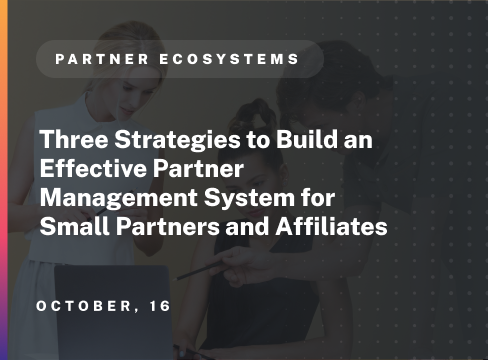Developing a robust, functioning partner management system for a large volume of partners and affiliates is a universal challenge. With limited resources, how can you ensure small partners and affiliates are as engaged and productive as strategic partners?
Tai Rattigan, Chief Operations Officer at Partnership Leaders, hosted a panel of industry leaders Ian Bellais, VP for Corporate Strategy at Verified First, Casey Paget, Senior Alliance Manager of Anaplan, Tony Simon, Senior Partner Program Manager at Deel, Antonio Caridad, Senior Director of Channel Programs at Megaport, Tom Williams, Managing Director at Edge Consulting, and Rachel Grosh, Partner Programs Lead at Udemy.
With so many partners to manage, it takes a lot of work to provide high-touch personal service to each one.
Let’s take a look at our panel’s three key strategies for an effective partner management system.
1. Referral Programs and Quota Retirement
Referrals are a precious currency that benefits both partners and vendors. However, generating referrals at scale can be challenging without the right incentives.
Deel’s Commission and Referrals Success
Deel designed a motivated program directly rewarding sales reps for driving partner referrals.
Rattigan explained, “During my time at Deel, we charged a 20% commission from our partners that received referrals. We roughly calculated what that’s going to be, and we just gave it to the sales reps. And rather than it being like a spiff, it’s quota retirement.”
They built a Slack bot to streamline the referral initiation process for reps.
This program has been hugely successful for Deel, scaling partner referrals significantly.
Considerations in Designing These Programs
There are several important factors to consider when creating a quota retirement referral program:
- Commission rate: The percentage or amount paid for referrals must be compelling enough to motivate sales reps to prioritize this. At the same time, you want to maintain reasonable margins on referral business.
- Eligibility: Determine criteria for sales reps to participate in the program. Do they need to be at a certain level or tenure? What requirements must they meet?
- Attribution: Have clear attribution models to identify which sales reps are responsible for specific referrals and allocate quota retirement accordingly.
- Communication: Promote the program internally and explain the compelling benefits for sales reps to drive engagement.
- Tracking: Build reporting to track key metrics like the number of referrals, referral revenue, and quota allocated.
With the right design tailored to your business, a quota retirement referral program can incentivize your sales team to generate valuable referrals proactively.
2. The Power of Personalized Partner Enablement
While top-tier partners may get white-glove onboarding and training, small or new partners often get little direct enablement. Providing personalized engagement opportunities can significantly improve their productivity and loyalty.
In-Person Training Drives Results
According to Caridad, Megaport’s APAC team was having great success providing in-depth, in-person enablement sessions for partners.
As he shared, “Our team in the Asia Pacific was having a lot of success with this… all that enablement was really translating into a lot of business.”
This high-touch training builds skills and drives actual results.
Balancing Personalization With Efficient Scaling

While in-person training is ideal for every partner management system, providing this level of high-touch enablement to all partners may not be feasible. Some alternatives to balance personalization and scalable delivery include:
- Onboarding webinars: Open Sesame is piloting monthly webinars for tier 3 partners. This allows more interaction than solely self-service.
- Quick-start programs: These programs offer in-person training for partners that meet defined criteria. This targets enablement to priority partners.
- Online training courses: Self-paced eLearning modules allow partners to learn at their own pace and revisit materials.
- Remote coaching: Dedicate partner managers or subject matter experts for remote 1:1 coaching sessions.
Enablement needs to align the level of personalization with each partner’s tier, revenue potential, and available resources. A blended approach can efficiently provide a personalized partner management system.
3. Rethinking Rigid Partner Tiering Structures
Tiering partners based on revenue, strategic value, and sales focus is standard practice. However, rigid tiering systems can create limitations in managing evolving partner relationships.
Limitations of Precious Metals Tiering
Traditional precious metals tiers like Gold, Silver, and Bronze are increasingly outdated systems for categorizing partnerships. As Rush pointed out, legacy tiered partner programs are passé as inherently designed to reward revenue contributions that are transactionally based, rather than recognizing partner’s total contributions.
Here are some of the challenges with precious metals tiering:
Lacks Nuance and Adaptability
Traditional tiers attempt to boil down multifaceted relationships into strict categories based primarily on revenue. This emphasis on sales volume fails to account for other critical strategic attributes of partnerships. Additionally, these tiers provide no clear path for switching as partnerships evolve.
Negative Connotations for Lower Tiers
Lower tiers like Bronze have a negative association, causing partners in those tiers to feel deprioritized. With only 3 or 4 broad tiers, segmentation is minimal. It becomes difficult to truly distinguish partners within the same tier.
Lack of Transparency in Criteria
There is minimal transparency for partners, who often lack visibility into the specific tiering criteria and progression path. The system can feel arbitrary rather than data-driven.
While easy to initially grasp, precious metal tiers simply lack the sophistication to capture nuanced partnership dynamics. More adaptive, multidimensional, and transparent approaches are required.
Considering More Dynamic Tiering Approaches
Instead of precious metals, some companies are shifting to more flexible tiering models:
- Multidimensional attributes: A “constellation” model with badges for different partnership attributes like technical expertise, delivery capabilities, and more. This accommodates partners with diverse strengths. Williams said, “This provides program agility to recognize partners with material value propositions without penalizing them for not being the biggest company.”
- Regular re-tiering: Conducting the tiering process quarterly or biannually ensures tiers adapt as the partnership matures.
- Quantitative metrics: Incorporate more quantitative metrics into tier criteria, not just revenue. Activity volume, growth trends, and customer satisfaction can provide meaningful insight.
- Tier stage gates: Defining specific milestones or requirements to “graduate” between tiers allows partners a clear path to advance.
Keeping Lower Tier Partners Engaged
With any tiering model, it’s critical not to isolate less mature partners.
Simon explained that creating “a self-service experience so that a partner can come in through the front door on board and have a fulfilling experience” is essential.
Resources like knowledge bases, open community forums, and guided onboarding tools can help educate and activate emerging partners.
Conclusion
Effectively managing a large, scaled partner ecosystem requires a thoughtful strategy and continuous refinement. While high-touch personalization may work for top-tier partners, developing blended approaches that support partners at all levels is critical.
Join The 1700+ Leaders Transforming Partnerships
As a member of Partnership Leaders you will:
- Build and learn with the top partner people at the best companies around the world.
- Increase your impact and accelerate your career with proven resources, tools, and best practices.
- Grow a network of peers, partners, and advisors with common objectives.


